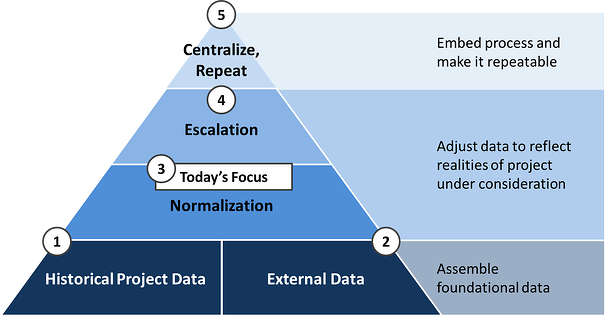What's the fundamental problem of accurate project estimation? New projects aren't like old ones.
Even when you have great historical project data and high-quality market data to inform your estimates, it's impossible to compare projects that differ from one another unless you have a systematic way to account for those differences in your estimates.
We've conducted rigorous statistical analyses and come up with 12 cost drivers that, when taken together, can affect project costs by >140% even after accounting for diameter, mileage, and escalation. In this week's post, we show you how to do that analysis yourself and come up with the cost driver variables that make sense for your company.
Interested in learning more about the cost drivers we've created from working with some of North America's leading midstream companies? Click here to learn more.
The 5 Steps to More Accurate Project Estimation
Step 3: Account for Project Cost Drivers
In order to compare unlike projects along the same baseline, midstream companies must come up with a way to quantify the unique factors that drive the costs of each project.
By developing a series of standard cost normalization factors, midstream companies can not only leverage their past project insights to predict future project costs, but they can also account for the embedded risks in future projects, from environmental risk factors to regional market conditions.
Our estimation experts recommend 4 steps that you can take to begin normalizing your projects today:
1. Gather historical cost information: Interview key project stakeholders to identify the unique costs that drove each past project.
2. Generate standard cost driver variables: Distill the findings from your stakeholder interviews into a standardized dossier of qualitative cost drivers (e.g., soil moisture, site conditions, regional affluence, etc.) and choose 2-5 possible options within each variable by which you'll categorize each project. Then, assign cost drivers to past projects.
| Read our guide to the 6 most overlooked cost drivers |
 |
Example: A population density variable could have rural, suburban, and urban choices. You classify Project 1 as rural, Project 2 as urban, and Project 3 as suburban.
3. Assign quantitative weights to each cost driver in order to establish a standard process for assessing the extent to which each variable affects total project costs. Calculate weights by conducting regression analysis on historical project data.
Example: All else equal, suburban projects are 3% more costly and urban projects are 7% more costly than rural projects. That's because increased population densities suggest that compensation costs will be higher, there will be more regulation, and more property will have to be uprooted, increasing ROW and damages costs.
4. Apply the framework to new projects: Determine how each new project ranks on each variable, and apply cost driver weights as determined in the company's standardized library.
Example: You don't know much about the scope of a new project, but your business development team needs to know whether an investment would be profitable, and they need to know yesterday. Since you know that the project would run through a populated area, you can adjust your baseline estimate upward by exactly 7%, since you know that projects in urban areas typically cost 7% more than projects in rural areas.
By developing a standard framework by which to quantify project costs, you can turn your past project data into a wealth of newly applicable cost information for predicting future project costs.
The Guide to Midstream Project Estimation
Or send us an email to learn more today

